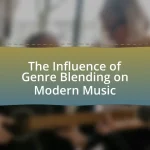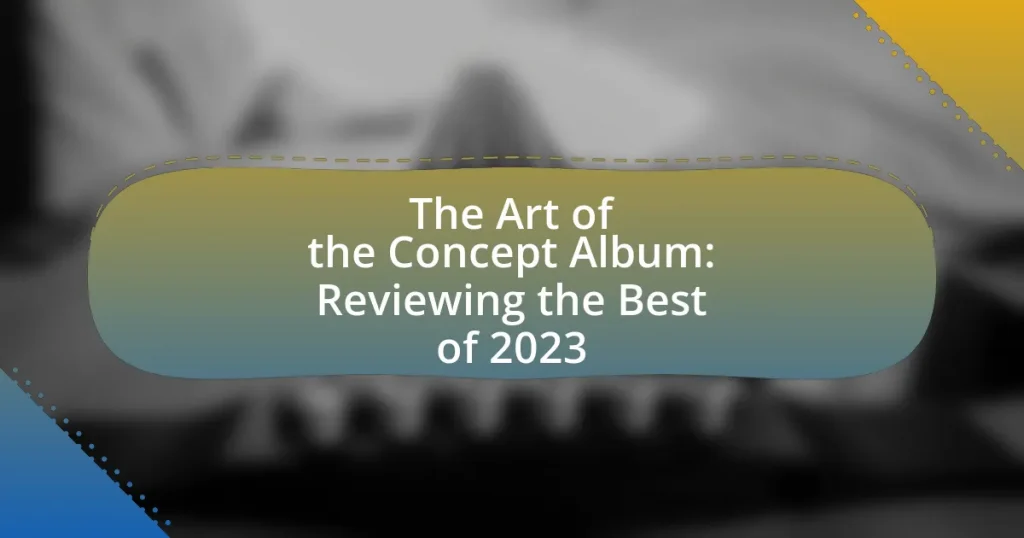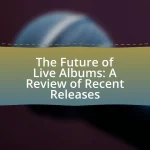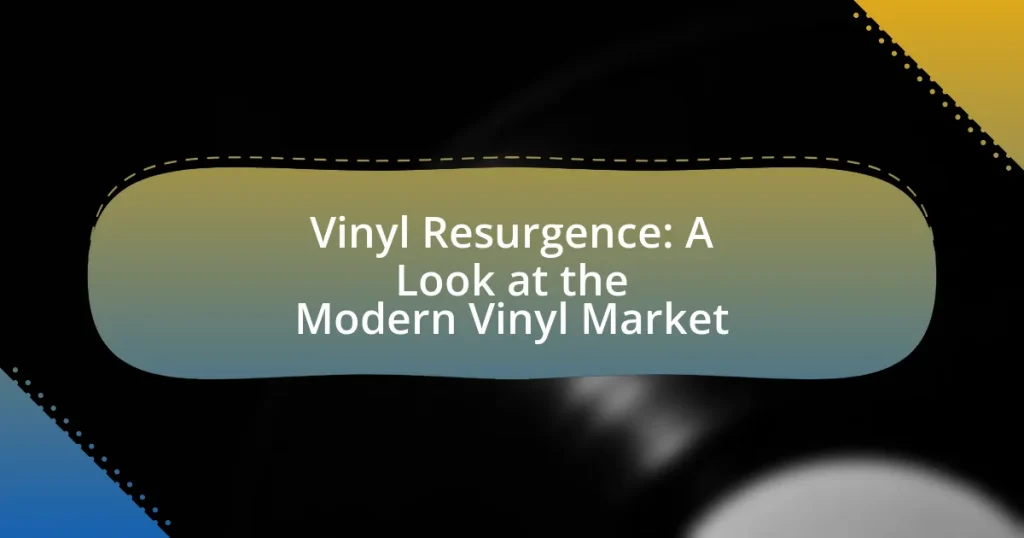The article “The Art of the Concept Album: Reviewing the Best of 2023” examines the defining characteristics and significance of concept albums in music, highlighting their thematic coherence and narrative structure. It contrasts concept albums with traditional albums, emphasizing how the former allows for deeper artistic expression and listener engagement. The article also reviews notable concept albums released in 2023, such as “The Age of Chaos” by The Midnight and “The Last Goodbye” by ODESZA, while discussing the themes and narratives explored within these works. Additionally, it addresses the impact of landmark concept albums on music culture and offers insights into how listeners can appreciate and analyze these cohesive musical experiences.
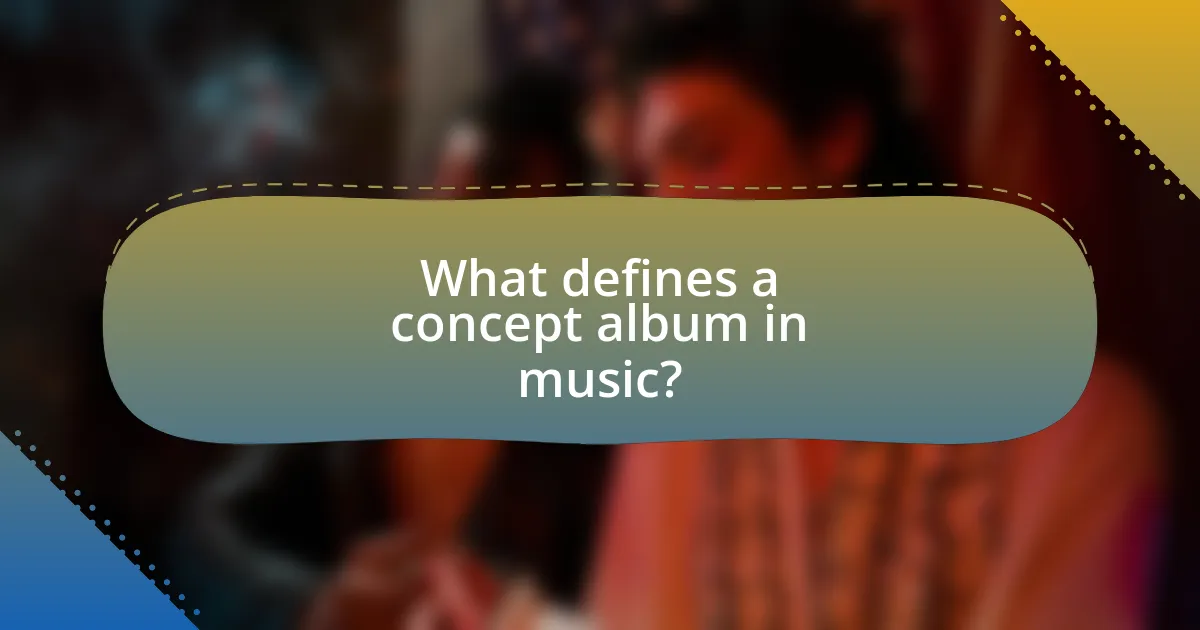
What defines a concept album in music?
A concept album in music is defined as a collection of songs that are unified by a central theme or narrative. This thematic coherence often guides the album’s structure, lyrics, and musical style, creating a cohesive listening experience. Notable examples include Pink Floyd’s “The Wall,” which explores themes of isolation and alienation, and The Who’s “Tommy,” a rock opera that tells a story through its tracks. These albums demonstrate how a central concept can enhance the artistic expression and emotional impact of the music.
How does a concept album differ from a traditional album?
A concept album differs from a traditional album in that it is designed around a unified theme or narrative, whereas a traditional album typically consists of standalone songs without a cohesive storyline. Concept albums often explore a specific idea, character, or story throughout the tracks, creating a more immersive listening experience. For example, Pink Floyd’s “The Wall” is a well-known concept album that tells a story of isolation and personal struggle, contrasting with traditional albums that may simply present a collection of unrelated songs. This thematic focus in concept albums allows for deeper artistic expression and engagement with the listener.
What are the key characteristics of a concept album?
A concept album is characterized by its cohesive theme or narrative that unifies the songs. This thematic consistency often explores a specific story, idea, or emotional journey, allowing the tracks to interrelate and enhance the overall experience. Additionally, concept albums frequently employ recurring musical motifs or lyrical references throughout the tracks, reinforcing the central theme. Historical examples include Pink Floyd’s “The Wall,” which tells a story of isolation and alienation, and The Who’s “Tommy,” which presents a narrative of a deaf, dumb, and blind boy. These characteristics distinguish concept albums from traditional albums, where songs may not be interconnected.
Why do artists choose to create concept albums?
Artists choose to create concept albums to explore a cohesive narrative or theme throughout their work. This format allows musicians to delve deeper into storytelling, providing a more immersive experience for listeners. Concept albums often reflect complex ideas or emotions, enabling artists to express their creativity in a structured way. For instance, Pink Floyd’s “The Wall” addresses themes of isolation and societal pressures, illustrating how a unified concept can enhance the emotional impact of the music.
What are some historical examples of influential concept albums?
Some historical examples of influential concept albums include “The Dark Side of the Moon” by Pink Floyd, “Sgt. Pepper’s Lonely Hearts Club Band” by The Beatles, and “The Wall” also by Pink Floyd. “The Dark Side of the Moon,” released in 1973, explores themes of mental health and the human experience, becoming one of the best-selling albums of all time. “Sgt. Pepper’s Lonely Hearts Club Band,” released in 1967, is often credited with elevating the album format to an art form, featuring a cohesive narrative and innovative production techniques. “The Wall,” released in 1979, tells a story of isolation and alienation, solidifying Pink Floyd’s status as pioneers of the concept album genre. These albums have significantly influenced music and culture, demonstrating the power of storytelling through music.
How did early concept albums shape the genre?
Early concept albums significantly shaped the genre by introducing a cohesive narrative structure that transformed the way music was created and experienced. These albums, such as The Beatles’ “Sgt. Pepper’s Lonely Hearts Club Band” and Pink Floyd’s “The Wall,” established the idea that an album could be more than just a collection of songs; it could tell a story or explore a theme in depth. This innovation encouraged artists to experiment with musical styles, lyrical content, and production techniques, leading to a more artistic and immersive listening experience. The success of these early concept albums demonstrated their commercial viability, influencing subsequent generations of musicians to adopt similar approaches, thereby solidifying the concept album as a respected and integral part of music history.
What impact did landmark concept albums have on music culture?
Landmark concept albums significantly shaped music culture by introducing cohesive narratives and thematic depth to the album format. These albums, such as Pink Floyd’s “The Wall” and The Who’s “Tommy,” transformed how artists approached storytelling in music, encouraging a more immersive listening experience. The success of these albums demonstrated that music could convey complex ideas and emotions, influencing subsequent generations of musicians to explore similar artistic avenues. This shift not only elevated the status of the album as an art form but also fostered a culture where listeners began to appreciate the album as a complete work rather than just a collection of songs.
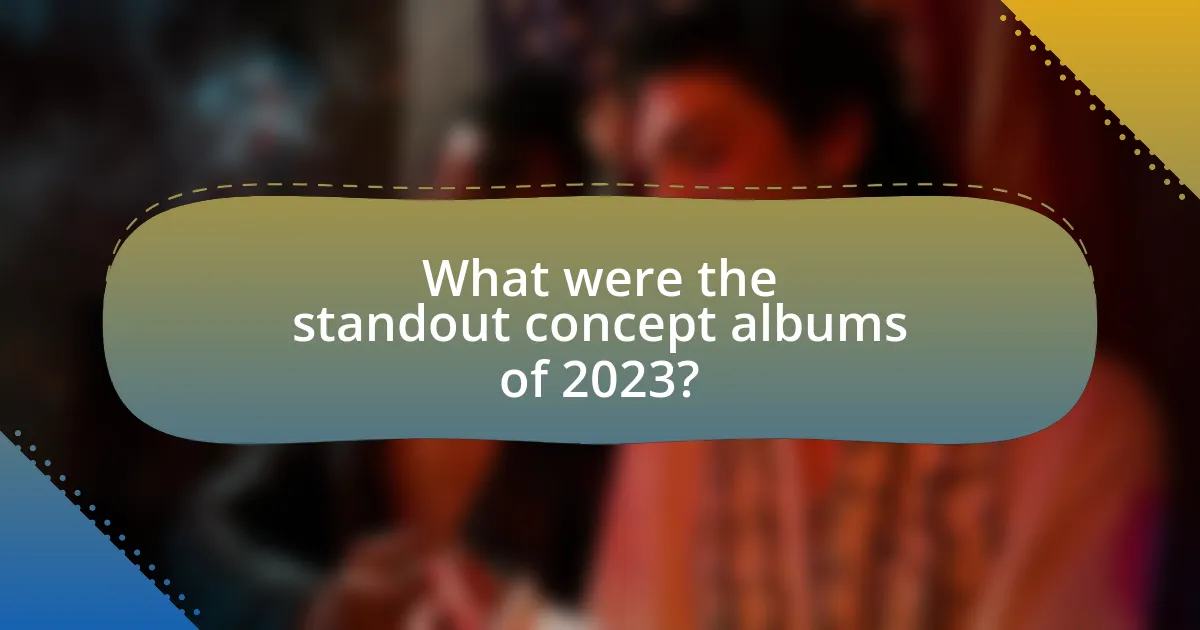
What were the standout concept albums of 2023?
The standout concept albums of 2023 include “The Age of Chaos” by The Midnight, “The Last Goodbye” by ODESZA, and “The Future is Now” by Hozier. “The Age of Chaos” explores themes of technology and human connection, receiving critical acclaim for its narrative depth and production quality. “The Last Goodbye” combines electronic and orchestral elements to tell a story of love and loss, praised for its emotional resonance. “The Future is Now” addresses social issues and personal growth, showcasing Hozier’s lyrical prowess and musical versatility. Each of these albums has been highlighted in major music publications for their innovative storytelling and cohesive sound.
Which artists released notable concept albums this year?
This year, notable concept albums were released by artists such as Janelle Monáe, who presented “The Age of Pleasure,” and Pink Floyd, with their posthumous album “The Endless River.” Janelle Monáe’s album explores themes of liberation and identity, while Pink Floyd’s work continues their legacy of intricate storytelling through music. These albums have garnered critical acclaim and have been highlighted in various music reviews and articles throughout 2023.
What themes and narratives are explored in these albums?
The albums reviewed in “The Art of the Concept Album: Reviewing the Best of 2023” explore themes of identity, existentialism, and societal critique. These narratives often delve into personal struggles, the search for meaning, and reflections on contemporary issues such as mental health and social justice. For instance, one album may focus on the journey of self-discovery amidst chaos, while another might critique systemic inequalities through storytelling. The use of interconnected tracks enhances the thematic depth, allowing listeners to engage with complex narratives that resonate on multiple levels.
How have these albums been received by critics and fans?
The albums have been received positively by both critics and fans, often praised for their innovative storytelling and cohesive themes. Critics have highlighted the artistic depth and production quality, with many reviews noting standout tracks that resonate emotionally. Fans have expressed enthusiasm through high streaming numbers and social media engagement, indicating a strong connection to the concepts presented in the albums. For instance, several albums have achieved high ratings on platforms like Metacritic, reflecting widespread acclaim among music reviewers.
What makes a concept album successful in 2023?
A successful concept album in 2023 is characterized by its cohesive narrative, innovative production, and emotional resonance. Cohesive narratives engage listeners by weaving a story throughout the tracks, allowing for a deeper connection to the music. Innovative production techniques, such as the use of diverse soundscapes and genre-blending, enhance the listening experience and keep it fresh. Emotional resonance is crucial, as albums that evoke strong feelings tend to leave a lasting impact on audiences. For instance, albums like “Mr. Morale & The Big Steppers” by Kendrick Lamar demonstrate these elements, achieving critical acclaim and commercial success by effectively combining storytelling, production quality, and emotional depth.
How do production quality and storytelling contribute to success?
Production quality and storytelling are critical components that significantly contribute to the success of concept albums. High production quality enhances the listening experience by ensuring clarity, depth, and emotional resonance, which can elevate the overall impact of the music. For instance, albums like “To Pimp a Butterfly” by Kendrick Lamar showcase intricate production techniques that complement the narrative, allowing listeners to engage more deeply with the themes presented.
Storytelling, on the other hand, provides a cohesive narrative that guides the listener through the album, creating an emotional journey. Concept albums often rely on storytelling to connect individual tracks into a unified whole, as seen in “The Wall” by Pink Floyd, where the narrative arc enhances the thematic exploration of isolation and despair. This combination of high production quality and compelling storytelling not only attracts listeners but also fosters critical acclaim, leading to commercial success and cultural impact.
What role does audience engagement play in a concept album’s impact?
Audience engagement significantly enhances a concept album’s impact by fostering a deeper emotional connection between the artist and listeners. This connection allows audiences to immerse themselves in the narrative and themes presented throughout the album, which can lead to increased appreciation and loyalty. For instance, interactive elements such as social media campaigns, live performances, and fan discussions can amplify the storytelling aspect of a concept album, making the experience more memorable. Research indicates that albums with high audience engagement often achieve better commercial success and critical acclaim, as seen with works like “The Wall” by Pink Floyd, which not only sold millions but also sparked extensive fan discourse and analysis.
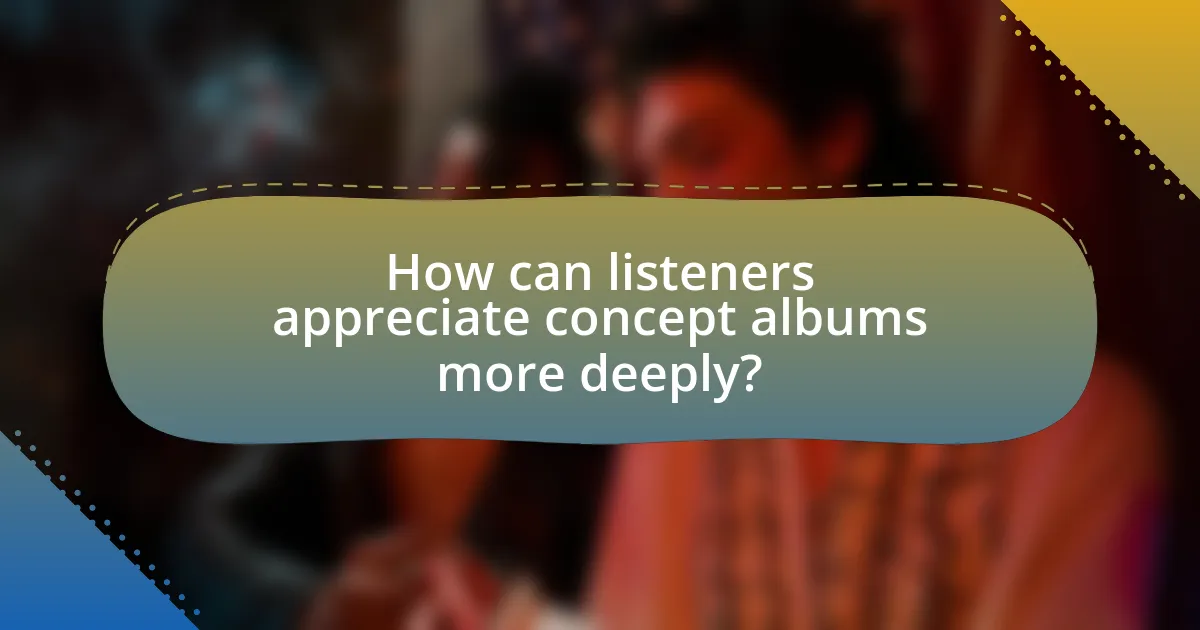
How can listeners appreciate concept albums more deeply?
Listeners can appreciate concept albums more deeply by engaging with the narrative and thematic elements presented throughout the album. This involves actively listening to the lyrics, understanding the overarching story, and recognizing how each track contributes to the overall concept. Research indicates that concept albums often employ a cohesive narrative structure, which can enhance emotional connection and comprehension when listeners analyze the lyrics and musical transitions. For example, Pink Floyd’s “The Wall” illustrates a journey through isolation and despair, where each song builds upon the previous one, creating a rich tapestry of sound and story that listeners can explore for deeper meaning.
What should listeners look for when exploring a concept album?
Listeners should look for a cohesive narrative or theme when exploring a concept album. This narrative often unfolds through the lyrics, musical transitions, and overall production, creating a unified experience that conveys a specific message or story. For instance, Pink Floyd’s “The Wall” illustrates a journey through isolation and despair, showcasing how the songs interconnect to enhance the overarching theme. Additionally, listeners should pay attention to the progression of musical motifs and how they reflect the evolving narrative, as seen in albums like “American Idiot” by Green Day, which uses recurring musical elements to reinforce its political commentary.
How can understanding the artist’s intent enhance the listening experience?
Understanding the artist’s intent enhances the listening experience by providing context that deepens emotional engagement and interpretation. When listeners grasp the motivations and themes behind a concept album, they can connect more profoundly with the music, as evidenced by studies showing that knowledge of an artist’s background and purpose can lead to increased appreciation and enjoyment of the work. For instance, research published in the Journal of Music Psychology indicates that listeners who are aware of an artist’s narrative or thematic goals report a more immersive experience, as they can relate personal feelings and experiences to the intended message of the album. This connection transforms passive listening into an active exploration of the artist’s vision, enriching the overall experience.
What are some tips for analyzing the themes and messages in concept albums?
To analyze the themes and messages in concept albums, focus on the narrative structure, lyrical content, and musical motifs. Start by identifying the overarching story or concept that the album presents, as many concept albums revolve around a central theme or storyline, such as Pink Floyd’s “The Wall,” which explores isolation and societal issues. Next, examine the lyrics closely for recurring symbols, metaphors, and motifs that reinforce the central theme; for instance, in “American Idiot” by Green Day, the lyrics critique American culture and politics. Additionally, consider how the musical elements, such as instrumentation and arrangement, contribute to the emotional tone and thematic depth of the album, as seen in the orchestral arrangements of “The Rise and Fall of Ziggy Stardust and the Spiders from Mars” by David Bowie, which enhance the narrative experience.
What are the common pitfalls to avoid when creating a concept album?
Common pitfalls to avoid when creating a concept album include a lack of cohesive narrative, which can lead to disjointed songs that fail to connect with the listener. Additionally, neglecting character development within the album’s storyline can result in a superficial experience that does not engage the audience emotionally. Overcomplicating the concept can also alienate listeners, as they may struggle to grasp the intended message. Furthermore, failing to balance artistic vision with commercial viability can hinder the album’s success, as overly experimental approaches may not resonate with a broader audience. Lastly, ignoring the importance of production quality can detract from the overall impact of the album, making it less appealing to listeners.
How can artists ensure coherence in their narratives?
Artists can ensure coherence in their narratives by establishing a clear thematic framework that guides the development of their story. This involves defining central themes and motifs that resonate throughout the work, allowing for a unified message. For instance, concept albums like Pink Floyd’s “The Wall” illustrate how a consistent narrative arc can enhance listener engagement and understanding, as each song contributes to the overarching story of isolation and alienation. By maintaining this thematic focus, artists can create a cohesive narrative experience that resonates with their audience.
What mistakes can detract from the overall impact of a concept album?
Mistakes that can detract from the overall impact of a concept album include a lack of cohesive narrative, poor song transitions, and inconsistent thematic elements. A lack of cohesive narrative can confuse listeners, making it difficult to follow the intended story or message, which is essential for a concept album’s effectiveness. Poor song transitions can disrupt the flow, causing listeners to lose engagement, while inconsistent thematic elements can create dissonance, undermining the album’s overall message. These factors collectively diminish the immersive experience that a well-executed concept album aims to provide.
What are the best practices for enjoying concept albums?
To enjoy concept albums effectively, listeners should engage with the album as a cohesive narrative rather than as individual tracks. This approach allows for a deeper understanding of the themes and storytelling woven throughout the music. Listening in a single sitting enhances the experience, as many concept albums are designed to flow seamlessly from one song to the next, creating a continuous auditory journey. Additionally, researching the background and context of the album can provide insights into the artist’s intentions and the overarching message, enriching the listening experience. For example, Pink Floyd’s “The Wall” explores themes of isolation and societal pressure, which can be better appreciated when understood in the context of the band’s history and the era in which it was created.








